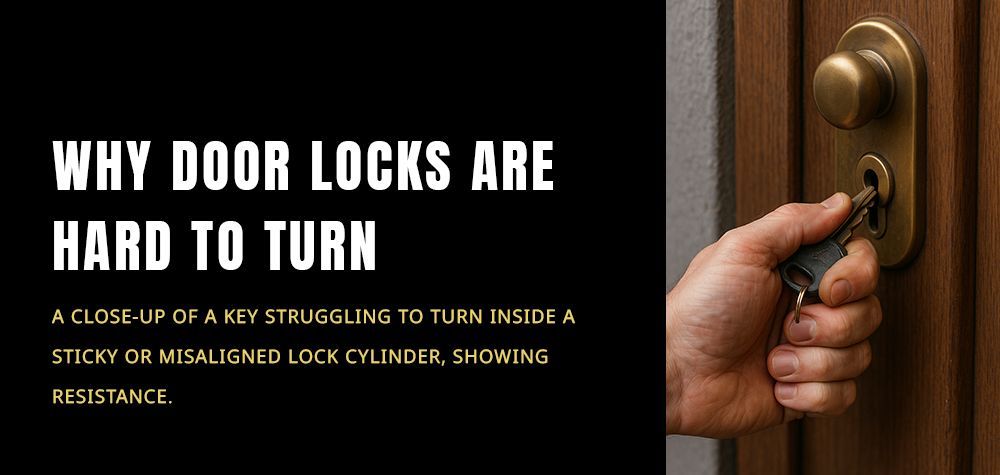Fixing a Broken Door Handle
A broken door handle can be both an inconvenience and a safety concern. Whether the handle is loose, completely detached, or simply malfunctioning, it can cause disruption in your daily routine. But before you consider calling a locksmith or replacing the entire door, there are several DIY solutions you can try to fix the broken door handle yourself. In this article, we will cover various methods for fixing a broken door handle, as well as preventive measures to avoid future issues.
How to Fix a Deadbolt Lock that Spins
Identifying the Issue: Understanding the Problem
Before diving into repairs, it’s important to first identify what exactly is wrong with the door handle. Door handles can fail for several reasons, and understanding the underlying cause will help determine the best solution. Here are some common reasons why door handles break:
- Loose screws: Over time, the screws that secure the door handle can loosen, causing the handle to wobble or fall off.
- Worn-out mechanism: If the internal mechanism, like the latch or spring, wears out or breaks, the handle might not function properly.
- Broken spindle: The spindle is the metal rod that connects the two sides of the handle. If it breaks, the handle may turn freely without engaging the latch.
- Faulty latch: A malfunctioning latch can prevent the door from closing or locking properly, which may also affect the handle.
Once you’ve identified the issue, you can move forward with the appropriate repair solution.
Solution 1: Fixing Loose or Detached Door Handles
One of the most common issues with door handles is a loose or detached handle. Often, this can be solved by tightening the screws or replacing any worn-out components. Here’s how to fix it:
Tighten the screws:
- First, inspect the screws holding the door handle in place. Use a screwdriver to tighten any loose screws. This is usually the quickest and easiest fix for a door handle that is loose or wobbly.
- If the screws are stripped or broken, you may need to replace them with new ones of the correct size. Ensure that the screws are long enough to securely hold the handle in place.
Replace the internal components:
- If tightening the screws doesn’t solve the problem, you may need to remove the handle and inspect the internal mechanism. Look for broken or worn-out parts, such as the spring, latch, or spindle.
- You can buy replacement parts at a hardware store or online. Be sure to get parts that match the specific model of your door handle.
Reassemble the handle:
- After replacing any broken parts, reassemble the handle and test it to ensure that it works smoothly. Make sure the screws are tight and the handle operates properly.
Solution 2: Repairing a Broken Spindle
If the spindle, the metal rod that connects the two halves of the door handle, breaks, the handle will turn without engaging the latch. A broken spindle can usually be fixed by replacing it. Here’s how:
Remove the broken handle:
- Use a screwdriver or drill to remove the screws from the door handle and pull the handle off.
Replace the broken spindle:
- Remove the old, broken spindle and replace it with a new one. You can find replacement spindles at most hardware stores, or you can purchase a universal one if your handle is a standard size.
- Insert the new spindle into the handle, ensuring that it fits securely into place.
Reattach the handle:
- Once the new spindle is in place, reassemble the handle and secure it to the door with screws. Test the handle to make sure it operates properly.
Solution 3: Fixing a Faulty Latch
If the door handle is still functioning but the latch is not catching properly, it could be that the latch mechanism is faulty. In this case, you may need to repair or replace the latch.
Inspect the latch mechanism:
- Look closely at the latch to see if it’s misaligned or damaged. Sometimes, a misaligned latch can prevent the door from closing completely. If this is the case, you may need to adjust the strike plate to realign the latch.
Replace the latch:
- If the latch is damaged or worn out, you’ll need to replace it. Most door latches can be replaced without removing the entire door handle. Simply unscrew the screws that hold the latch in place, remove the old latch, and install a new one.
Reassemble and test:
- Once the new latch is installed, reassemble the door handle and test the functionality to ensure the latch engages properly when you turn the handle.
Solution 4: Dealing with Stubborn Door Handles (Rust or Paint)
If the door handle is stiff or difficult to turn, it might be due to rust, paint buildup, or dirt within the mechanism. Here’s how to clean and fix a stubborn handle:
Remove the handle:
- Use a screwdriver to remove the screws and detach the handle from the door.
Clean the mechanism:
- Use a cloth and mild cleaner to remove any dirt or paint buildup around the handle. You can also use a small brush to clean hard-to-reach areas.
- If rust is the issue, use a rust remover to clean the metal components. Be careful not to damage the finish of the handle.
Lubricate the mechanism:
- Apply a small amount of lubricant to the moving parts of the handle, such as the spindle and latch mechanism. This will help the handle turn smoothly and prevent further buildup of rust or dirt.
Reassemble and test:
- After cleaning and lubricating the handle, reassemble it and test it to ensure it moves freely.
Preventing Future Door Handle Problems
Once you've successfully repaired your door handle, it’s important to take steps to prevent future issues. Here are some preventative measures to consider:
Regular maintenance:
- Periodically check your door handles for signs of wear and tear. Tighten any loose screws and lubricate the moving parts to keep them functioning smoothly.
Avoid over-tightening:
- While it's important to tighten screws, avoid over-tightening them, as this can damage the handle or the door. A snug fit is usually sufficient.
Keep handles clean and dry:
- Moisture and dirt can cause handles to rust or become stiff. Regularly clean your handles and make sure they remain dry to prevent buildup.
Use quality door handles:
- Invest in high-quality door handles made from durable materials. Cheaper handles tend to wear out faster and may require more frequent repairs.
Conclusion
A broken door handle doesn’t always require the assistance of a professional locksmith. By identifying the issue, understanding the mechanism, and following the right DIY steps, you can easily fix a broken door handle and restore the functionality of your door. Whether the problem is loose screws, a broken spindle, a faulty latch, or rust, there are effective solutions available. By performing regular maintenance and taking preventive measures, you can keep your door handles in good condition for years to come.
Remember, if you're unsure or the problem persists despite your efforts, it’s always a good idea to consult with a professional to ensure your home remains secure.
Call Us Any Time!







